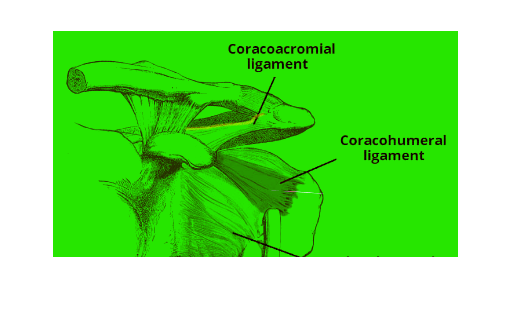Quick Overview
Coracohumeral ligament (CHL) is a strong ligament that helps to stabilize the shoulder joint. It is located on the front of the shoulder and connects the coracoid process (a bony hook on the shoulder blade) to the greater tuberosity of the humerus (the upper arm bone).

Table of Contents
Anatomy of Coracohumeral Ligament
The Coracohumeral Ligament is a fibrous band that originates from the coracoid process of the scapula and extends to attach to the greater and lesser tubercles of the humerus (the upper arm bone). Its location and structure contribute to its essential role in shoulder stability.
Importance in Shoulder Stability
The Coracohumeral Ligament is a crucial player in shoulder stability. It acts as a restraint to excessive movement, particularly in the anterior (front) direction. By limiting excessive anterior glide of the humeral head, it prevents dislocation and ensures the smooth functioning of the shoulder joint during various activities.
Location and Structure
The CHL is located on the front of the shoulder, just below the coracoid process and above the greater tuberosity of the humerus. It is a broad, triangular ligament that is made up of two layers i,e, a superficial layer and a deep layer.
Attachments of the Coracohumeral Ligament
The Coracohumeral Ligament has two primary attachments:
1- Coracoid Process: It originates from the coracoid process of the scapula.
2- Greater and Lesser Tubercles: The ligament attaches to both the greater and lesser tubercles of the humerus.
Also read Ulnar Collateral Ligament (UCL)
Functions
The CHL has several important functions, including;
- Stabilizing the shoulder joint
- Preventing anterior and inferior dislocation of the humeral head
- Resisting external rotation of the humerus
- Protecting the long head of the biceps tendon
Clinical Significance
The CHL is involved in several common shoulder injuries, including;
- Subacromial impingement syndrome
- Rotator cuff tears
- Shoulder instability
Causes
CHL injuries can be caused by a variety of factors, most common are;
- Trauma: A direct blow to the shoulder or a fall on an outstretched hand can cause a CHL injury.
- Overuse: Repetitive overhead activities can lead to overuse injuries of the CHL.
- Degeneration: The CHL can degenerate as we age, making it more susceptible to injury.
Diagnosis
CHL injuries are typically diagnosed based on a physical examination and the patient’s medical history. Imaging tests, such as an X-ray or MRI, may be ordered to confirm the diagnosis and assess the severity of the injury.
Treatment and Rehabilitation
Treatment for CHL injuries depends on the severity of the injury. Mild injuries may be treated with rest, ice, compression, and elevation (RICE). More severe injuries may require physical therapy or surgery.
Physical therapy can help to strengthen the muscles around the shoulder and improve range of motion. Surgery may be necessary to repair a torn CHL.
Prevention
There are a few things you can do to prevent CHL injuries, including:
- Warming up before participating in physical activity
- Strengthening the muscles around the shoulder
- Using proper form when performing activities that involve overhead arm movements
- Avoiding activities that aggravate the shoulder
Questions
Q: How can I tell if I have a coracohumeral ligament injury?
Common symptoms of a coracohumeral ligament injury include:
1- Pain in the front of the shoulder
2- Swelling in the front of the shoulder
3- Decreased range of motion of the shoulder
4- Instability of the shoulder
If you experience any of these symptoms, it is important to see a doctor or physical therapist to get a diagnosis.
Q: How long does it take to recover from a coracohumeral ligament injury?
The recovery time for a coracohumeral ligament injury depends on the severity of the injury. Mild injuries may heal within a few weeks, while more severe injuries may take several months to heal. If surgery is required, the recovery time can be even longer.
Q: Can I still play sports after a coracohumeral ligament injury?
Yes, you can still play sports after a coracohumeral ligament injury, but it is important to follow your doctor’s instructions and gradually return to activity. It is also important to wear a brace or other supportive device to protect your shoulder from further injury.
Q: What are the risks of surgery for a coracohumeral ligament injury?
Surgery for a coracohumeral ligament injury is generally safe and effective. However, there is a small risk of complications, such as infection, nerve damage, and stiffness. It is important to discuss the risks and benefits of surgery with your doctor before making a decision.
Q: How can I prevent a coracohumeral ligament injury?
There are a few things you can do to prevent a coracohumeral ligament injury, including:
1- Warming up before participating in physical activity
2- Strengthening the muscles around the shoulder
3- Using proper form when performing activities that involve overhead arm movements
4- Avoiding activities that aggravate the shoulder
